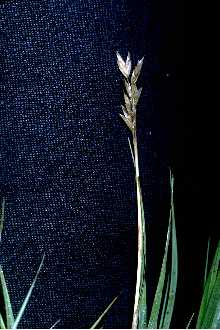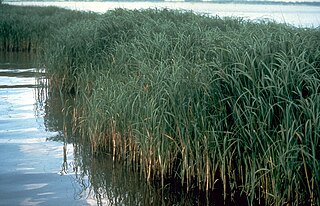
A halophyte is a salt-tolerant plant that grows in soil or waters of high salinity, coming into contact with saline water through its roots or by salt spray, such as in saline semi-deserts, mangrove swamps, marshes and sloughs, and seashores. The word derives from Ancient Greek ἅλας (halas) 'salt' and φυglycophytes. An example of a halophyte is the salt marsh grass Spartina alterniflora. Relatively few plant species are halophytes—perhaps only 2% of all plant species. Information about many of the earth's halophytes can be found in the halophyte database.

The Great Basin Desert is part of the Great Basin between the Sierra Nevada and the Wasatch Range. The desert is a geographical region that largely overlaps the Great Basin shrub steppe defined by the World Wildlife Fund, and the Central Basin and Range ecoregion defined by the U.S. Environmental Protection Agency and United States Geological Survey. It is a temperate desert with hot, dry summers and snowy winters. The desert spans large portions of Nevada and Utah, and extends into eastern California. The desert is one of the four biologically defined deserts in North America, in addition to the Mojave, Sonoran, and Chihuahuan Deserts.

Distichlis palmeri is an obligate emergent perennial rhizomatous dioecious halophytic C4 grass in the Poaceae (Gramineae) family. D. palmeri is a saltwater marsh grass endemic to the tidal marshes of the northern part of the Gulf of California and Islands section of the Sonoran Desert. D.palmeri is not drought tolerant. It does withstand surface drying between supra tidal events because roots extend downward to more than 1 meter where coastal substrata is still moist.

Atriplex hymenelytra, the desert holly, is silvery-whitish-gray shrub in the family Amaranthaceae, native to deserts of the southwestern United States. It is the most drought tolerant saltbush in North America. It can tolerate the hottest and driest sites in Death Valley, and remains active most of the year.

Atriplex watsonii is a species of saltbush known by the common name Watson's saltbush, or Watson's orach. It is native to the coastline of California and Baja California, where it grows in coastal areas with saline soils, such as salt marshes and beach scrub, with other halophytes such as saltgrass. It extends inland in the Los Angeles Basin, and along the Santa Ana River.

Dasyochloa is a monotypic genus containing the single species Dasyochloa pulchella, known as desert fluff-grass or low woollygrass, a densely tufted perennial grass found in the deserts of the southwestern United States and northern Mexico.

Leymus triticoides, with the common names creeping wild rye and beardless wild rye, is a species of wild rye. It is native to western North America from British Columbia to California and Texas.
Puccinellia howellii is a rare species of grass known by the common name Howell's alkaligrass. It is endemic to Shasta County, California, where it is known from a single population in Whiskeytown National Recreation Area near Whiskeytown. Its entire population is contained in a 1-acre (4,000 m2) complex of three saline mineral springs directly next to Highway 299. The grass was first described to science in 1990 and no other populations were discovered despite extensive searches of the area.
Distichlis bajaensis is a rare species of grass known by the common name Baja grass.

Zeltnera namatophila, the spring-loving centaury, is a rare species of flowering plant in the gentian family. It is endemic to the Amargosa Valley, in Nye County, southwestern Nevada.

Elymus lanceolatus is a species of grass known by the common names thickspike wheatgrass and streamside wheatgrass. It is native to North America, where it is widespread and abundant in much of Canada and the western and central United States. There are two subspecies, subsp. lanceolatus occurring throughout the species' range and subsp. psammophilus occurring in the Great Lakes region.
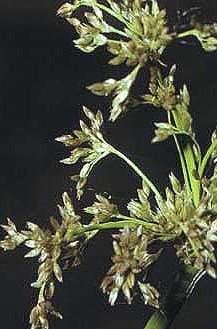
Juncus roemerianus is a species of flowering plant in the rush family known by the common names black rush, needlerush, and black needlerush. It is native to North America, where its main distribution lies along the coastline of the southeastern United States, including the Gulf Coast. It occurs from New Jersey to Texas, with outlying populations in Connecticut, New York, Mexico, and certain Caribbean islands.

Panicum repens is a species of grass known by many common names, including torpedo grass, creeping panic, panic rampant, couch panicum, wainaku grass, quack grass, dog-tooth grass, and bullet grass. Its exact native range is obscure. Sources suggest that the grass is native to "Africa and/or Asia", "Europe or Australia", "Eurasia", "Australia", "Europe, Asia, and Africa", or other specific regions, including the Mediterranean, Israel, and Argentina. It is present in many places as an introduced species and often a noxious weed. It has been called "one of the world's worst weeds."
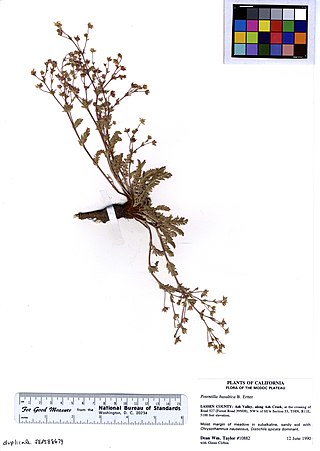
Potentilla basaltica is a species of flowering plant in the rose family known by the common names Soldier Meadows cinquefoil and basalt cinquefoil. It is endemic to a small area of the Modoc Plateau and Warner Mountains in northeastern California and northwestern Nevada.

Borrichia frutescens is a North American species of flowering plants in the family Asteraceae known by the common names sea oxeye, sea oxeye daisy, bushy seaside tansy, and sea-marigold. In Veracruz it is called verdolaga de mar. It is native to the United States and Mexico, where it occurs along the Atlantic and Gulf Coasts. Its distribution extends from Maryland south to Florida and west to Texas in the US, and along the Mexican Gulf Coast to the Yucatán Peninsula. It is an introduced species in some areas, such as Bermuda and Spain.
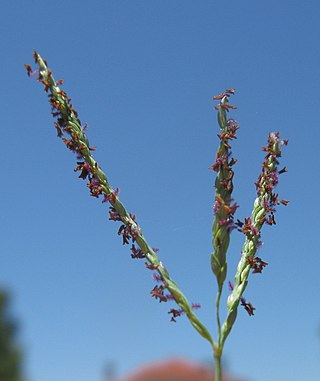
Digitaria didactyla is a species of grass known by the common names blue couch, Queensland blue couch, blue serangoon grass, green serangoon grass, blue stargrass, and petit gazon. It is native to Mauritius, Réunion, parts of mainland Africa, and Madagascar. It has been introduced widely outside its native range, mainly for use as a pasture and turf grass. It has naturalized in some regions.

Alysicarpus vaginalis is a species of flowering plant in the legume family, Fabaceae. It is native to parts of Africa and Asia, and it has been introduced to other continents, such as Australia and the Americas. It is cultivated as a fodder for livestock, for erosion control, and as a green manure. Common names include alyce clover, buffalo clover, buffalo-bur, one-leaf clover, and white moneywort.
An alkali sink is a salty basin land form. In these depressions, which are found only in the San Joaquin Valley, California, rainwater drains to the basin and collects in areas where it cannot penetrate the soil due to a hard layer of clay or caliche, producing a pond or lake. When the water evaporates, it leaves behind increasing amounts of salt and minerals in the soil, creating a high pH level in the water and soil.

Grindelia fraxinipratensis, common name Ash Meadows gumweed, is a North American species of flowering plants in the family Asteraceae. It is native to the southwestern United States, in Mojave Desert regions in Nye County in Nevada and Inyo County in California. Some of the Nevada populations lie inside the Nevada Test Site of the United States Atomic Energy Commission

Aeluropus lagopoides, sometimes called mangrove grass or rabbit-foot aeluropus, is a species of Eurasian and African plant in the grass family, found primarily in salty soils and waste places.
